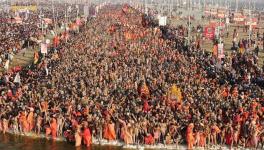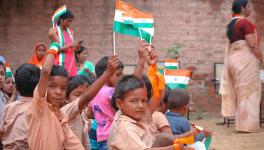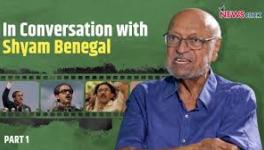Where Were Communists During India’s Freedom Struggle?
The dominant narrative about the Indian freedom movement is that Mahatma Gandhi and the Indian National Congress were the prime agents who drove the British from India. There also exists another strong though marginal narrative—usually pushed vigorously by the RSS and family—that multiple other factors contributed to India’s freedom from British rule. This counter-narrative is driven by the desire to discredit and delegitimise the Congress and the “Gandhi-Nehru” legacy, which played a very crucial role in shaping popular accounts of the anti-colonial struggle.
There are other narratives; about Subhas Chandra Bose and his INA, the famous mutiny of the Royal Indian Navy and the post-war mass upheavals, etc. All in all, the post-war situation developed in such a way that governing India became increasingly difficult for the British and it had no option but to quit India, sooner rather than later.
Lost between all these narratives is the role played by the communist groups and the Communist Party of India (CPI) in the freedom struggle. The role is evident in party documents and acknowledged in academic works and journals, but the part played by communists is largely absent from popular public memory.
The fact that the Communist party did not participate in the Quit India Movement in 1942—which is often falsely equated with the non-participation of the RSS and Hindu Mahasabha—is rather well-known. What is not known is that their reasons for not participating were completely contrasting. Moreover, the position of the Communist party on the Quit India Movement must be understood in the context of its position on the anti-colonial struggle before Quit India and it must be compared with that of the Hindu Mahasabha and the RSS.
For this it is important to get a sense of the 1920s and the different stages of Communists’ struggle against the British Raj.
-
The Peshawar Conspiracy Cases (1922-1927): These were initiated in five phases by the British government against 40 to 50 muhajirs, who had formed the CPI in 1920 in Tashkent. Tashkent was a part of the Soviet Union and these leaders gained political and military training there and at the Communist University of the Toilers of the East in Moscow. The muhajirs were mainly Khilafatis who intended to go to Turkey to fight the British, but they met MN Roy in Tashkent and with him laid the foundation of the first Communist Party of India. They were charged under section 121-A, and accused of fermenting “a proletarian revolution against the British imperialist oppressors to restore freedom to the masses”.
-
The Kanpur Communist (Bolshevik) Conspiracy Case (1924-25): This was initiated against communist leaders—many of whom had come from the Tashkent group and others were peasant and worker activists from different parts of India—like Shaukat Usamni, Muzaffar Ahmed, SA Dange, MN Roy, Muzaffar Ahmad, Singaravelu Chettiar, Ghulam Hussain and others. According to the British Government, these leaders were working “to deprive the King Emperor of his sovereignty of British India, by complete separation of India from imperialistic Britain by a violent revolution” and they were slapped with section 121-A.
-
The Meerut Conspiracy Case (1929-1933): This was the most significant trial which established the Communist Party of India as a party of the peasantry and working class. Several Trade Union leaders from across India were arrested along with three Englishmen associated with the Communist International and put on trial for organising a strike among workers of Indian Railways and Textile industry. The leaders were Shaukat Usmani, SA Dange, Muzzafar Ahmed, Sohan Singh Josh, PC Joshi and Philip Spratt among other. They were slapped with section 121-A. The Meerut trials followed a wave of trade union activity, organisation and strikes in major industrial centres of India in late-1920s as a result of the Great Depression.
It was the leftists who first demanded complete independence, at the 1921 Ahmedabad Session of the Congress, where a manifesto signed by communist leaders was distributed and a resolution was proposed by Maulana Hasrat Mohani. The CPI was formally organised in 1925 and since its inception fought for complete independence of India. Consequently, it was banned and worked through the Workers and Peasants Party.
In 1927, a new constitution of the Communist party was decided in a meeting of its leaders in Bombay (now Mumbai). The new constitution reiterated the demand for “complete independence, universal suffrage, abolition of landlordism, nationalisation of public utilities, etc. While the Meerut case was going on, the CPI raised a draft platform for action in 1931, declaring its objectives of an Indian Revolution. Some of them were, a) complete independence of India by the violent overthrow of British rule. Cancellation of all debt. Confiscation and nationalisation of all British factories, banks, railway, sea and river transport and plantations, and b) The 8-hour working day and the radical improvement of conditions of labour. Increase in wages and state maintenance for the unemployed. Equal pay for equal work for women, youth and men, c) the abolition of rank, caste, national and communal privileges and full equality of all citizens respective of sex, religion, race etc.
In order to achieve these objectives, the Communist party established a range of mass organisations for workers, peasants, women, students, artists and writers. It organised several strikes, such as the famous Bombay Textile Strike of the late 1920s. From the early 1930s on, many communist leaders joined the Indian National Congress in an attempt to radicalise the anti-colonial struggle.
As the Second World War broke out, communists were the first to organise anti-war demonstrations. Several industrial strikes were organised in Bombay [now Mumbai], Calcutta [now Kolkata], Kanpur, Madras, Dhanbad, Digboi and so on. These anti-war demonstrations were hugely popular and saw participation of hundreds of thousands of workers.
Subhas Chandra Bose extended his support to these anti-war demonstrations. The CPI changed its position on the Second World War after the German invasion of the Soviet Union and decided to join the anti-fascist forces, which ultimately led to its non-participation in the Quit India Movement. After the war ended, the CPI again organised peasants and workers throughout the country and demanded immediate independence.
The historian Sekhar Bandhopadhyay notes, “The wake of strike in Indian industries reached its peak in 1946 when more than 12 million man-days were lost and this figure was more than three times higher than in the previous year. And apart from industries, workers struck at the Post and Telegraph Departments and in the South Indian Railways and North Western Railways”. These mass actions furthered the growing realisation among the British that they could no longer control the affairs of India.
The counter-narrative of the Indian Freedom Struggle is the strike by Royal Indian Navy in Bombay [now Mumbai] in January 1946, followed by a mutiny in the following month. The revolt spread rapidly to other naval bases and ships at sea and sympathetic strikes were observed in Royal Air Force and the Indian Army. At its peak, 78 ships, over 20,000 ratings [enlisted members of the Navy] and 20 shore establishments were involved in the revolt. The mutiny was supported by ordinary people and the working classes of Bombay, who went on a sympathetic strike, bringing the public transport system to a standstill. The working class of Bombay went on an industrial strike and public barricading followed. These strikes had been called by the Communist party and, interestingly, both the Congress and the Muslim League denounced the strikes. The INC called the strikers “misguided”, while Gandhi criticised them for violence and Sardar Patel persuaded the mutineers to surrender. Only the communists and some socialists supported the mutineers, who carried the flags of all the three parties—the Red Flag, the Congress flag and that of the Muslim League.
The Case of Quit India:
Ever since its formation, the CPI declared complete independence of India as its goal. This reflected in its pamphlets, booklets and manifestos. The Communist party adopted this position almost a decade before the Congress did. The CPI followed the Marxist-Leninist philosophy and advocated that real independence meant the establishment of a socialist state and abolition of all conditions of exploitation and oppression. They not only identified the British as the enemy of Indian people but also the Indian landlord and capitalist classes, whose wealth was created by the exploitation of the toiling masses. Therefore, their main thrust was on organising peasants and working classes across India against the British and Indian capitalists and landlords.
The position of the CPI on the Quit India Movement must be analysed against this context. Its position remained the same—that is, in favour of complete independence of India through a militant and uncompromising struggle and commitment to the global anti-fascist struggle—before and after the Quit India movement. The CPI never watered down its position on complete independence. That is why even as the war progressed, it could organise peasant revolts across the country: the Tebhaga movement in Bengal in 1943, the Telangana movement in Hyderabad Princely State over 1946-51, the Punnapra-Vayalar Struggle of 1946 in Travancore, the Revolt of the Warlis in 1945-47 in Maharashtra, among others.
On the other hand, the Hindu Mahasabha and the RSS never declared any anti-British agenda. They never declared achieving India’s independence from the British as their goal. Instead, they collaborated and worked closely with the Raj and gained many favours. Both the Mahasabha and the RSS did not budge from this position even in 1947. The former condemned the Quit India Movement as “sterile, unmanly and injurious to the Hindu cause” and the second chief of the RSS even categorised anti-Britishism as reactionary! He asked the Hindus not to participate in the freedom struggle. Golwalkar said: “Hindus, don’t waste your energy fighting the British; save your energy to fight our internal enemies that are Muslims, Christians and Communists.”
Today, the position of the communists with respect to Quit India looms so large that it becomes the sole vantage point to imagine and discuss their role, pushing aside their contributions. But contrary to this popular view, the communists were in the thick of the freedom struggle since the very inception of their movement. For their desire for complete independence, they led multiple struggles which frustrated the British (as well as Indian ruling classes) and eventually led to their exit on 15 August 1947.
Harshvardhan is PhD candidate at Centre for the Study of Social Systems, JNU and Prabal Saran Agrawal is PhD candidate at Centre for Historical Studies, JNU. The views are personal.
Get the latest reports & analysis with people's perspective on Protests, movements & deep analytical videos, discussions of the current affairs in your Telegram app. Subscribe to NewsClick's Telegram channel & get Real-Time updates on stories, as they get published on our website.
























